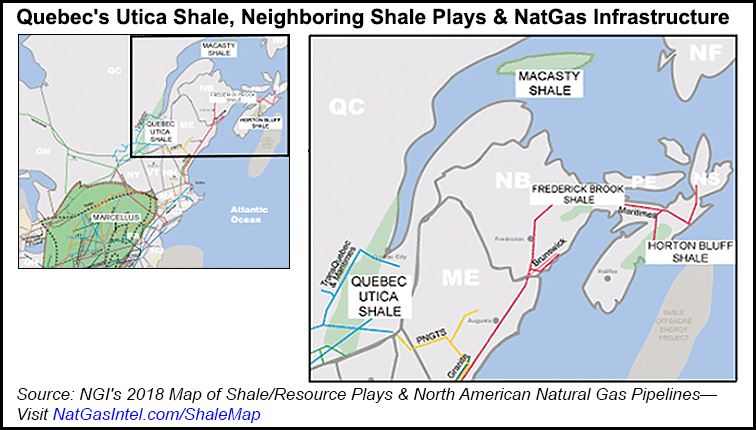NGI The Weekly Gas Market Report | Infrastructure | NGI All News Access
Quebec Urged to Consider Utica Shale Natural Gas in Energy Transition to Zero Emissions
Natural gas holds the key to achieving French Canada’s declared climate change and energy transition policy goals, including tapping abundant Utica Shale reserves, to move Quebec toward an all-electric future, according to a Montreal research agency.

The role for increasing the use of gas has risen from the need to free up power that the province currently dedicates to heating for charging the batteries in zero-emissions cars and trucks, Montreal Economic Institute (MEI) researchers said in a new paper, “Energy in Quebec: What Role for Natural Gas in the Context of Electrification?”
Thanks to government-owned Hydro Quebec’s power dams, nearly nine in 10 of the province’s 8.5 million residents use electric heating.
“Supposing that the number of vehicles in circulation in Quebec remains the same as it is today?” researchers asked. “At the end of a completed energy transition, some 5.4 million personal electric vehicles would require around 37,350 MW just to recharge each day, or almost as much as the province’s peak demand in winter.”
A new generation of electricity “smart meters” could average the increased power grid load down to about 3,100 MW by spreading the vehicle recharging over 12 hours/day, according to research by engineer Jean Michaud and economist Germain Belzile.
Going all the way on energy transition by also electrifying the 823,000 trucks active in Quebec would about double the added load on the French Canadian power grid to more than 6,100 MW.
Industrial energy requirements, native resistance against new dams, provincial aquatic nature preserves, and popular opposition to building atomic power plants limit Quebec’s ability to cater to electric vehicles, the researchers said.
“If Quebec used natural gas instead of electricity for heating, this would free up a large amount of electricity that would facilitate the electrification of other sectors of the economy.”
The MEI researchers pointed out that even though Quebec stands out as a Canadian hotbed of popular disdain for fossil fuels, the province annually spends more than C$1 billion ($750 million) on gas, which includes fueling backup power generation plants.
“Natural gas is already Hydro-Québec’s resource of last resort to produce all the electricity needed for heating during peak winter periods,” researchers said. “This solution is much less onerous than building hydroelectric facilities that would work only a few hours a year.”
Researchers pointed to Quebec’s untapped share of the Utica Shale geological formation south of the St. Lawrence River, which is estimated to harbor up to 40 Tcf of natural gas, as a source for fuel supply and new economic activity.
At the current rate of consumption in Quebec, the MEI paper estimated, about 212 Bcf a year in consumption would be sufficient for at least 40 years.
“If the development costs make economic sense, it would be irresponsible not to take advantage of this local resource, situated near current and potential consumers, which will create jobs and wealth in addition to being intrinsically cleaner than the same resource we are currently importing,” said researchers.
Quebec clouds the provincial vision of a zero-emissions French Canada with a government ban against hydraulic fracturing, which has ruled the Utica off limits to development. That ban has fostered demand for more gas in fossil fuel industry-friendly jurisdictions, the MEI paper said.
“Quebec’s stubbornness in refusing to develop its own natural gas resources is hypocritical,” said researchers. “By importing its natural gas — from the United States and Western Canada — Quebec ”hides’ the emissions that result from its consumption, for which it is ultimately responsible. In other words, we blame American and Western Canadian producers for our pollution.”
© 2024 Natural Gas Intelligence. All rights reserved.
ISSN © 1532-1231 | ISSN © 2577-9877 | ISSN © 1532-1266 |
